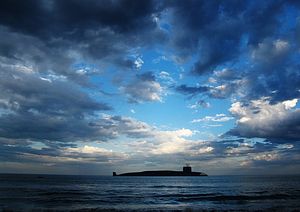In the last few months India seems to have reached a major milestone in its quest to field a credible minimum nuclear deterrent. The Hindu has reported that India’s first ballistic nuclear submarine (SSBN), the INS Arihant (which means destroyer of enemies), has been secretly moved out of harbor for sea trials. Contrary official sources have said that it will be moved out very soon. The submarine was launched in 2009 by Prime Minister Manmohan Singh. It has since been undergoing harbor trials, and its 83 MW nuclear reactor went critical in August 2013. Sea trials represent the final stage before being inducted into the Indian Navy. Another three sister submarines are already under various stages of construction at Visakhapatnam in Andhra Pradesh, where the first one was also built under a top secret project.
In another development, the Defense Research and Development Organization (DRDO) recently tested a 3,000 km range submarine launched ballistic missile (SLBM) named K-4, from a pontoon submerged 30 feet deep, off the coast of Visakhapatnam located on the eastern coast. This is the latest in a long line of successful missile tests in recent times by the DRDO, and reflects India’s maturing missile development capabilities. The K series of underwater missiles are named after former President Abdul Kalam, who was instrumental in developing the Indian missile development program.
Once operational, this SLBM will form a crucial leg of India’s nuclear triad, and also the most credible and hardest to detect. It will also make India the sixth country in the world to field nuclear submarines with ballistic missiles. Indeed former President APJ Abdul Kalam has said India has a “sixth nation” syndrome, referring to India as the sixth country in the world to develop many crucial technologies. He has called on India to correct this.
Together, though, India’s technologies give credence to its second strike capability in line with the Indian Nuclear Doctrine. India has pledged a “no first use” nuclear policy, but warns of a swift and massive retaliation in the event of a nuclear strike on its soil, or on its forces or assets anywhere abroad.
The longer range K-4 will complement the shorter range K-15, also known as Sagarika, with a range of 750 km. The K-15’s range is a significant limitation, and constricts room for maneuvering. The submarine has to move close to enemy shores to launch the missile, making it vulnerable to detection. The K-4, with a range of 3,000 km, gives the submarine enough standoff distance to fire while remaining hidden deep in the Indian Ocean, or within territorial waters. Each Arihant class submarine, displacing 6000 tons, can carry four K-4 missiles or twelve K-15 missiles. While the K-15 has been repeatedly tested and validated, the K-4 has only been test fired for the first time. Several more tests are required before it can be cleared for serial production and operationally deployed.
The K-4 has until now been tested from submerged pontoons in the absence of a submarine. During sea trials the Arihant is expected to fire the missile, validating the crucial mating of the missile with the submarine, and completing the triad in the process. It now looks as if that phase is imminent, as the DRDO has said it is confident of its induction in 2015. Coincidentally, this has happened under the new BJP-led National Democratic Alliance government, which carried out a series of nuclear tests in 1998 and originally put forward the nuclear doctrine. Also, in its election manifesto the new government pledged to revise the nuclear doctrine, and there is speculation that there may be a shift from the stated policy of no first use. The nuclear doctrine in fact states that it will be reviewed every five years. So a review incorporating recent developments and the changed reality of the sub-continent is perhaps overdue.
More important than the no first use policy is the need to review and strengthen the C4ISR (Command, Control, Communications, Computers, Intelligence, Surveillance and Reconnaissance) capabilities and procedures. In the case of land-based missiles or aircraft, the warheads and delivery systems are at different locations. In contrast, on a submarine both the nuclear warheads and their delivery vehicles (the missile), are close by, and the submarine is far from the mainland, which multiplies the risk of accidental launches or mishaps.
The effect these developments will have on the dynamics of the sub-continent remain to be seen. Nonetheless, they are a significant boost to India’s quest to field a nuclear triad, and will enhance its stature in the international community.
Dinakar Peri is an Associate Fellow at the Centre for Land Warfare Studies (CLAWS), the autonomous think tank of the Indian Army based in New Delhi. Follow him on Twitter @dperi84

































